by Gary Smith, June 2016
Set the Wayback Machine to 1999.
Oldest son grew tired of sharing a bedroom with his younger brother, eight years his junior. That’s fine, but we’re all out of bedrooms. The only remedy to this unfortunate turn of events is to move out of my home office. But where to go?
Idea! “Hey, I know. I’ve never heard of anybody doing anything like this.” I’ve since learned that just because I can dream up a creative solution to a problem doesn’t mean that I should try it. It might be the start of a new craze. But more likely than not there are reasons why wandering off the beaten path is to walk alone. The idea seemed to have merit only because I didn’t realize that I was about to be blindsided by the law of unintended consequences.
My idea? Buy an old Airstream trailer, park it next to the house, and turn it into an office.
What could possibly go wrong?

The happy if somewhat naive couple with their newly acquired 1967 Airstream.
So in 1999 I paid way too much for a ’67 Airstream. It smelled a little funny, but it wasn’t that bad inside. Very retro cool. Had a BIG A/C unit on the roof. That’s good, because I live in a Phoenix suburb. Gets hot here.
The owner was happy to have it towed to my house. Maybe a bit too happy.
Anything this retro is cool. The kids think it’s cool. Wife thinks it’s cool. OK. I can make this work. When I’m done with it, I’ll sell it as a cool, old Airstream trailer and let the next guy refurbish it.
Dawning Awareness
The door was the beginning of sorrows (and maybe the last straw). The curved aluminum door was totally Buck Rogers cool. I soon noticed, however, that it took two tries to securely close the door. The initial half-hearted attempt would not latch the door. A second try with considerably more force invariably would end with the door completely shut. But the sound was anything but satisfying. This is no Mercedes. The slam reverberated through the trailer and was accompanied by a tremor. Anticipating the slam, my eyes would close and my teeth clench. Like waiting for the other shoe to drop. The process repeated itself when exiting. “I’ve got to fix that door.” Unfortunately, the solution to fix the latch was not adjustment, but replacement. It was all worn out. Never did find a replacement. The latch was damaged because the door hinges were worn, and the door sagged a bit striking the latch in the wrong place. Increasing closing force overcame the mismatch.
Several amenities in the thing offended my sense of good taste. Had to be dealt with. For example, the ’70s shag carpet had to go. It looked like dirt. Only dirt would have smelled better.
How to Build an Airstream
The Airstream trailer was constructed thus: A bare plywood floor was secured to the aluminum chassis. Twelve inch square linoleum tiles were glued to the plywood. Then the major pieces of the interior that would be too large to get through the door were installed. Like the fiberglass bathroom tub/shower unit. The refrigerator and oven were placed on the linoleum. They became the supporting structural members that held up the cabinetry and counter top. Then at some point the shell was dropped on and attached through the wood floor to the frame. How do I know this?
I know this because when I took out the shag carpet, the glue that held many of the linoleum tiles in place had long since given up. More were loose than not, revealing that the plywood had water damage in places. OK. So the flooring needs to be replaced. No big deal. I’ll slide out the refrigerator and oven that were resting on the linoleum to get all of the loose tiles out. Except to do that the cabinetry and counter top had to be removed because they were attached to the appliances. Several hours later I gave up trying to be careful. The refrigerator and oven were out, but the cabinetry was destroyed. Too much glue. Too many screws. Too much dried-out wood from sitting through too many Arizona summers. The units were never designed to be serviced or replaced.
The other side of the kitchen had the sink and range. So I ripped all of that out also so the kitchen would be destroyed symmetrically. Not pretty.
Dawning conclusion: The whole thing needs to be gutted. Which was a shame because a lot of the wood trim inside was in pretty good shape.
The more I worked, the worse things looked. The bathroom consisted of a curved, fiberglass shower and tub that was formed to fit the curved back end of the trailer. Way too big to get out the door. A sawzall made short work of the bathtub. But it pained me greatly to cut it up.
After a couple of weeks the back yard looked like a trailer park after a tornado.

After a couple of weeks the back yard looked like a trailer park after a tornado.
The condition of the factory plywood floor deteriorated as I progressed closer to the bathroom, removing the tile. I ended up sealing the floor and added a new floor layer on top because, if you will recall, the edges of the original floor were sandwiched between the frame and the shell. The old floor could not be removed.
Then there was the holding tank. Let’s just say that it was removed and discarded using thick rubber gloves. I think a mask was also involved. I’ll let it go at that. The details are too horrible to recount.
The rebuild
Eventually I got to electrical issues. The trailer was wired for 110 and 12 volt. There was a big lead acid battery that, of course, had leaked all over the place. At one point I heard a zis-zis sound from an outlet. Weird. So I took the plug cover off to inspect. At this point I should remind readers that what was intended to go into this Airstream was my office. Computers were a part of the equipment list. Computers like stable power. They don’t like aluminum wiring and its corresponding connectivity issues. Guess what the Airstream had for wiring? Aluminum was all the rage in the ’60s.
Rewiring the trailer meant drilling out a zillion pop rivets that held the curved aluminum walls and ceiling panels to the trailer’s supporting ribs. Between the walls and exterior surface was all of an inch of fiberglass insulation. Wires couldn’t be easily pulled though holes in the ribs because they’d catch in the holes. What a mess. It took a couple of weeks to rewire the trailer. As a footnote I should mention that the insulation looked like fiberglass. I’m not dead yet so maybe it wasn’t asbestos.
10/3 wire was run from the box at the house through the attic to the trailer. Probably a couple of hundred feet of wire. Some of the attic goes over a vaulted ceiling where crawl space is very restricted. Didn’t have any fun that day.
The Air Conditioner
With the electrical in, it was time to try the big A/C unit on the roof. It worked great and blew cold air. But it sounded and vibrated like a Pratt and Whitney bomber engine. Who knows how much electricity it would have used. So scratch that. I bought a modern window A/C and put it in the back of the trailer through a panel I made to replace the stock holding tank access cover. What’s another $350 at this point?
I’ve got to fix that door.
The New Office
Phoenix is called the valley of the sun. That’s because there are over 300 days of sunshine a year. The Airstream was rebuilt as an office in the winter months during mild weather. As things heated up outside, I realized that my new aluminum office was a giant heat sink. Heat (or cold) would transfer from the aluminum skin through the aluminum ribs into the aluminum interior walls. It was hard to heat and even harder to cool. The one-inch-thick insulation’s only real purpose must have been to serve as an annoyance to anyone foolish enough to attempt rewiring the trailer.
 Idea! Shade would help keep the thing cooler. The Airstream came with supports for a retractable awning, but no aluminum roll-up support tube and no awning. So I went down to Arizona RV Salvage (kinda seedy) and bought the parts I was missing. I spent a couple hundred dollars there, so in appreciation (I suppose) they gave me a hat with their logo on it. I still have it and wear it when I’m doing something stupid that shouldn’t need to be done at all (It’s gotten a lot of use). When the awning support was repaired, I ordered a canvas awning. Got it all together.
Idea! Shade would help keep the thing cooler. The Airstream came with supports for a retractable awning, but no aluminum roll-up support tube and no awning. So I went down to Arizona RV Salvage (kinda seedy) and bought the parts I was missing. I spent a couple hundred dollars there, so in appreciation (I suppose) they gave me a hat with their logo on it. I still have it and wear it when I’m doing something stupid that shouldn’t need to be done at all (It’s gotten a lot of use). When the awning support was repaired, I ordered a canvas awning. Got it all together.
Did the awning help shade the trailer? Well, no. I wasn’t expecting, for example, that it would take two people and twenty minutes to extend or retract it. I also wasn’t expecting that extended it would act as an aerodynamic aid to an otherwise land bound vehicle. With the awing deployed, any wind would rock the trailer. Consequently, it didn’t get used much. So much for shade.
Once in the summer I left house for a couple of hours with the awning extended. While we were gone the sky turned black with wind and rain. Two of my kids were home and managed to get the awning somewhat retracted before trailer and awning ended up in Oz. They were drenched.
Speaking of rain, in certain conditions the roof would leak. And if the rain were really coming down, it was like being inside a popcorn popper.
Towards the back there was a roof vent with a plastic skylight. The sun had won the UV light war with the plastic decades prior. The vent got sealed permanently. There were many other openings in the trailer for vents or exhaust that had to be sealed.
By the way, any disturbance caused by wind, rain, occupants, or opening and closing the door would cause annoying trailer movement. It felt like a southern California tremor.
The only things that got hotter than the skin of the trailer were the single pane windows. Adding maximum reflective window tinting helped with the heat transfer, but did nothing to stop the leaks.
Exterior Refinishing
The exterior was originally polished aluminum with a protective clear coat. The sun in Phoenix laughs at clear coat. So the surface was kind of OK in the areas where the clear coat was still intact. But those areas were few and far between. Mostly it was tarnished and oxidized. Restoring the aluminum to a bright polished surface would have taken a trip to an aircraft polishing facility. I wasn’t about to spend what was necessary to polish the thing, especially considering it had a few dents. So I bought some aluminum acid wash (nasty stuff), and cleaned it up the best I could.
Ball and Chain
All of my equipment was in the trailer. There was no way to really secure it. Then there were climate control concerns. No way was I going to leave it with a space heater or air conditioner running for any extended length of time. It ended up that I couldn’t leave it, and I could hardly stand to be in it.
Conclusion
The Airstream would have worked fine (except for the door) if it had been placed inside a shop or warehouse out of the weather. But then, if I had a shop or warehouse that large, I wouldn’t have needed the Airstream.
I endured the Airstream Office for about eight months. Then I built an office in the garage.
Some guy answering my Craigslist ad bought the Airstream for what I paid for it. So I only lost about $3,500 in improvements and maybe 200 hours of my time. Not bad considering I learned a hard lesson.
“I’m going to tow it to a beach in California and use it for a photo lab.”
I told him that was a great idea.
By the way, I never got the door to work right.

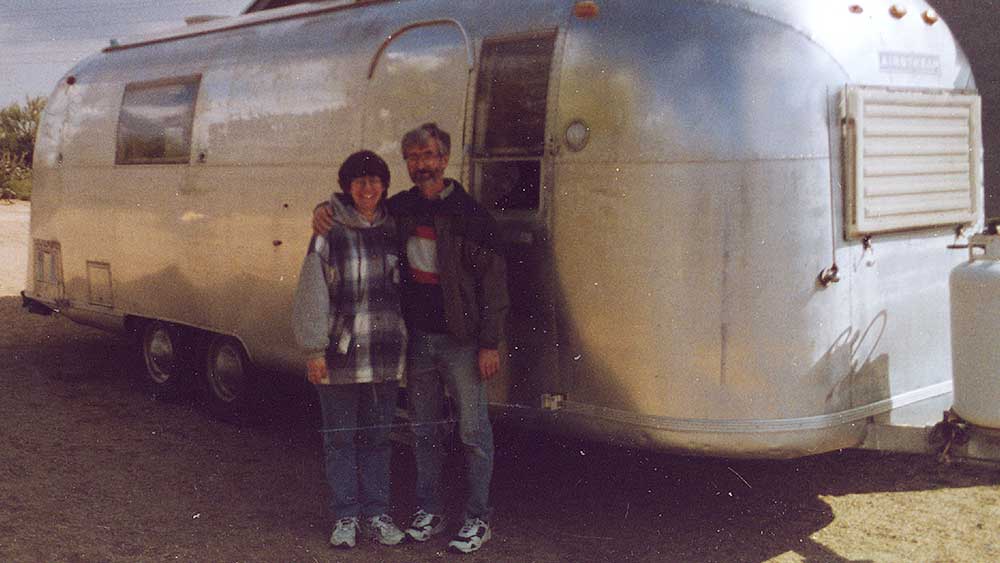
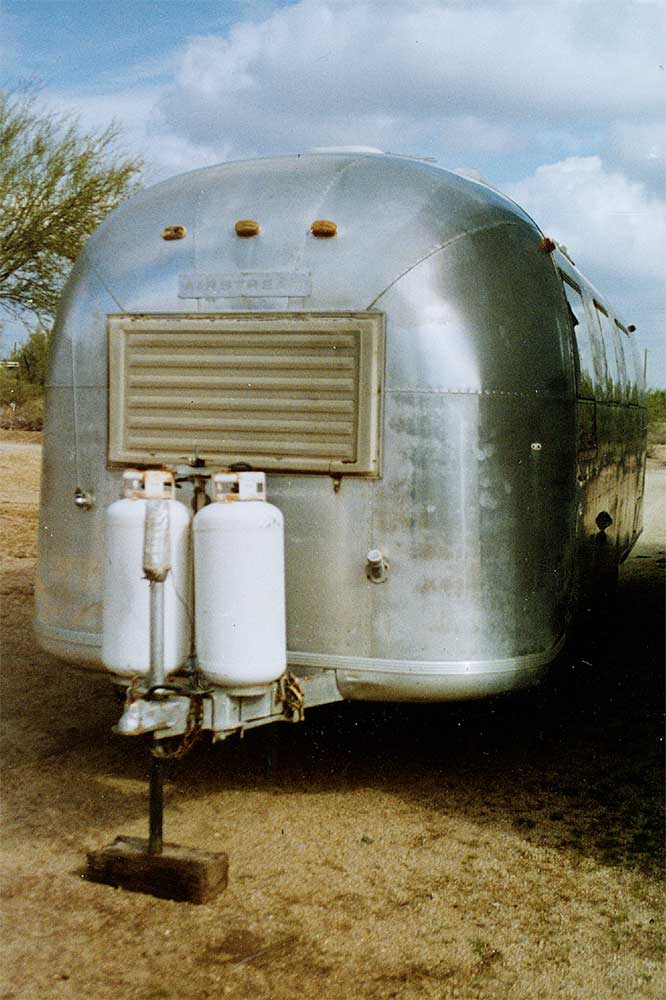
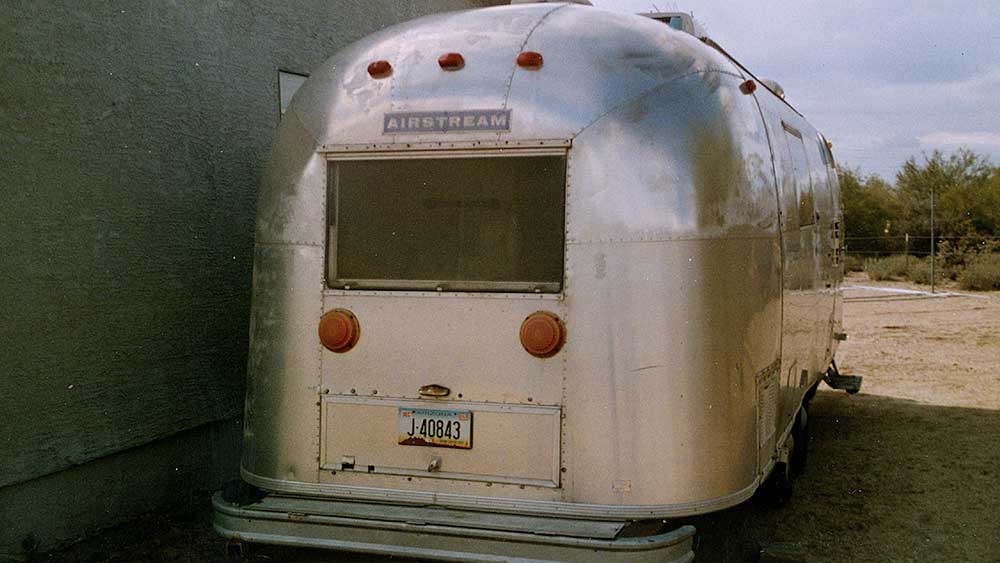
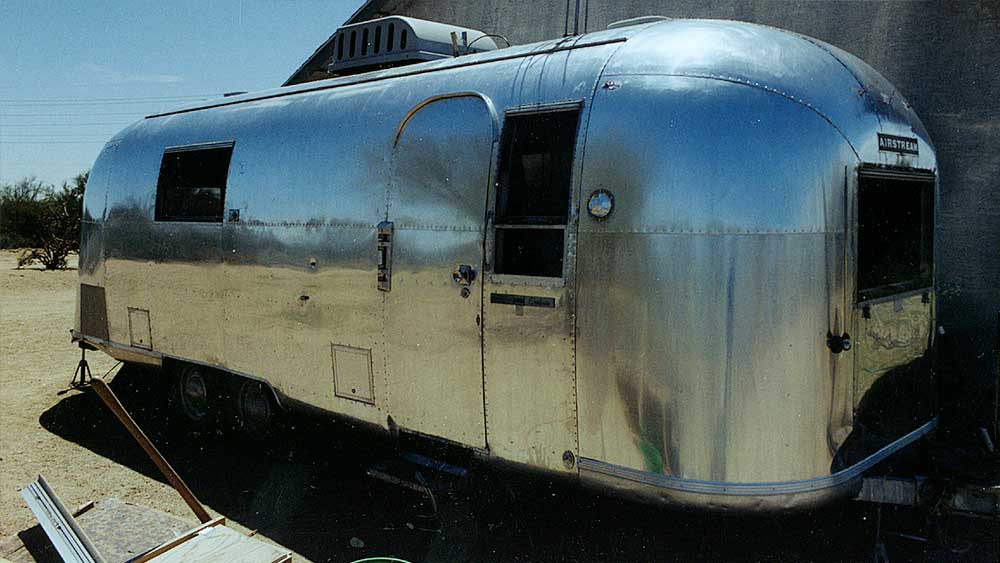
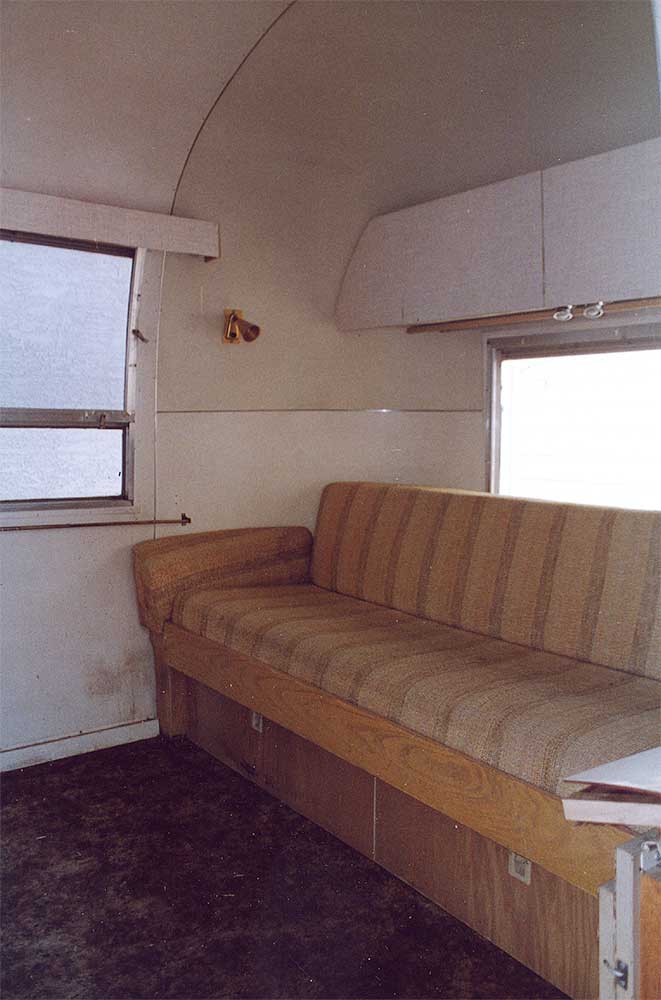
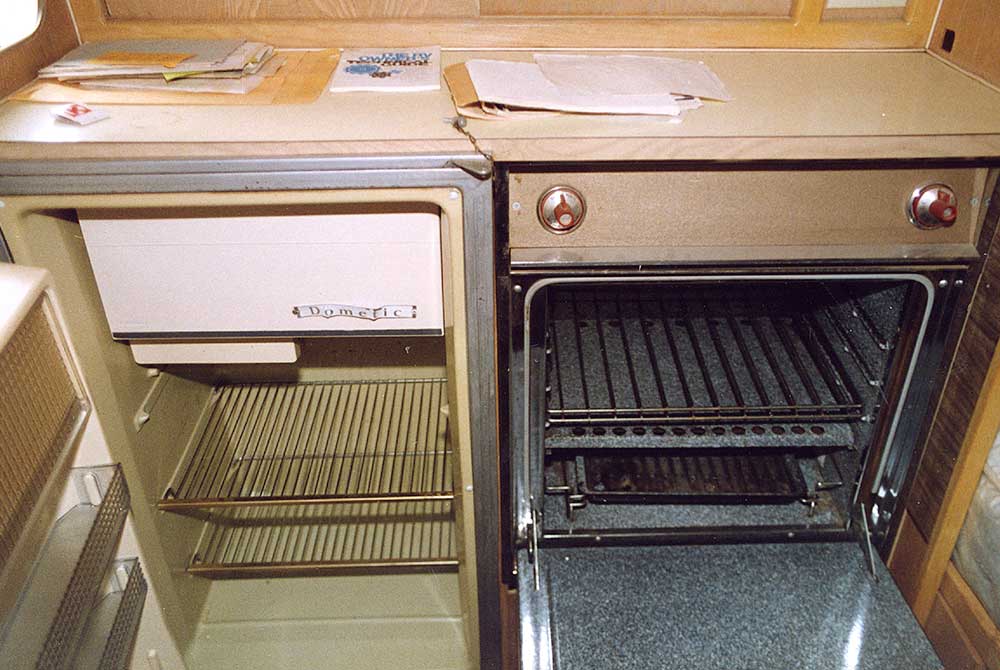
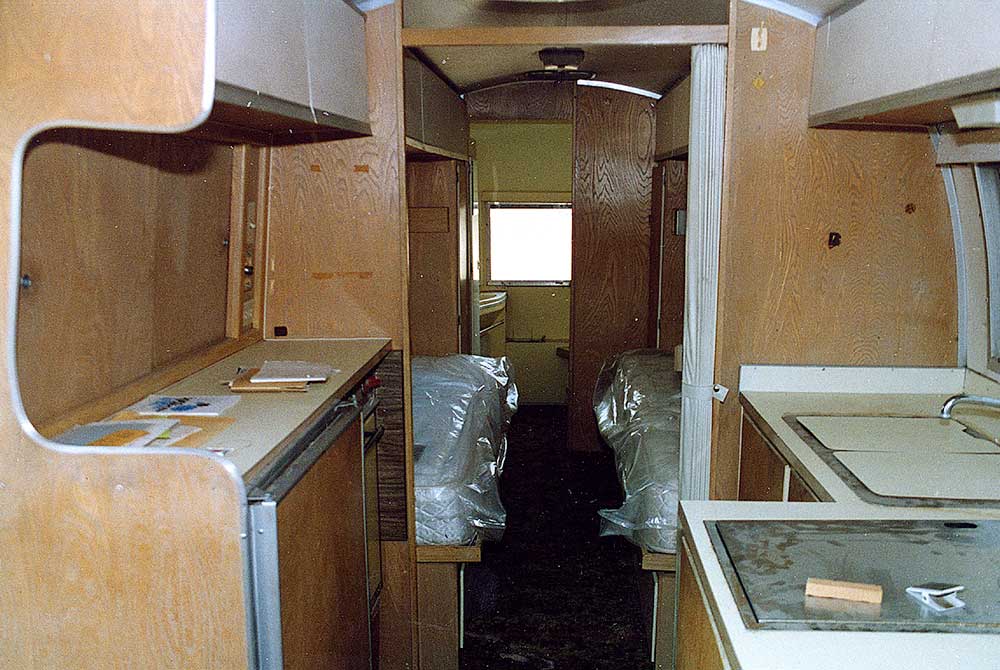
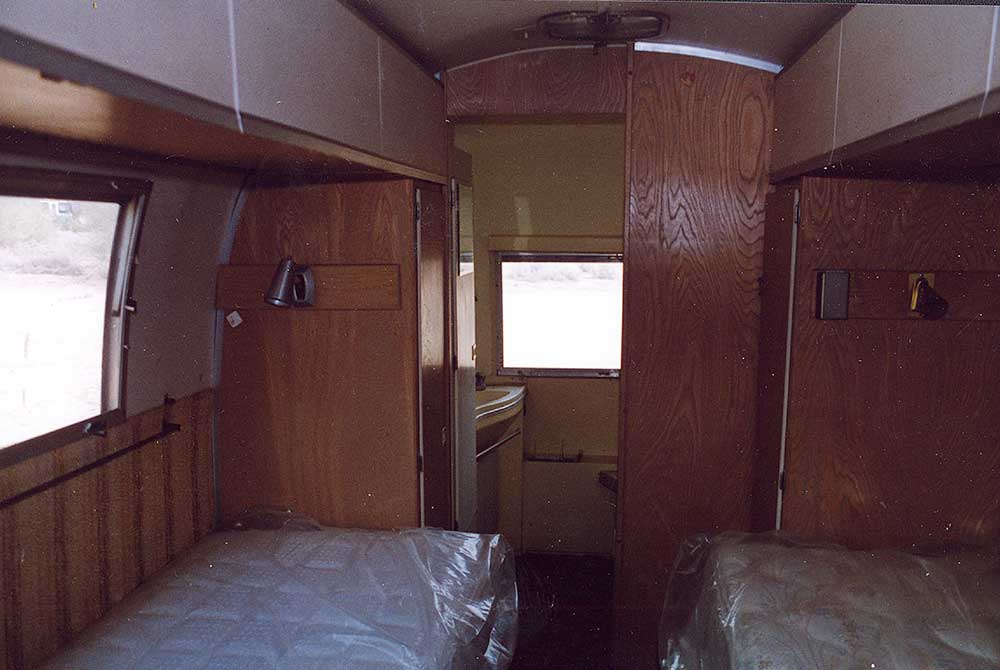
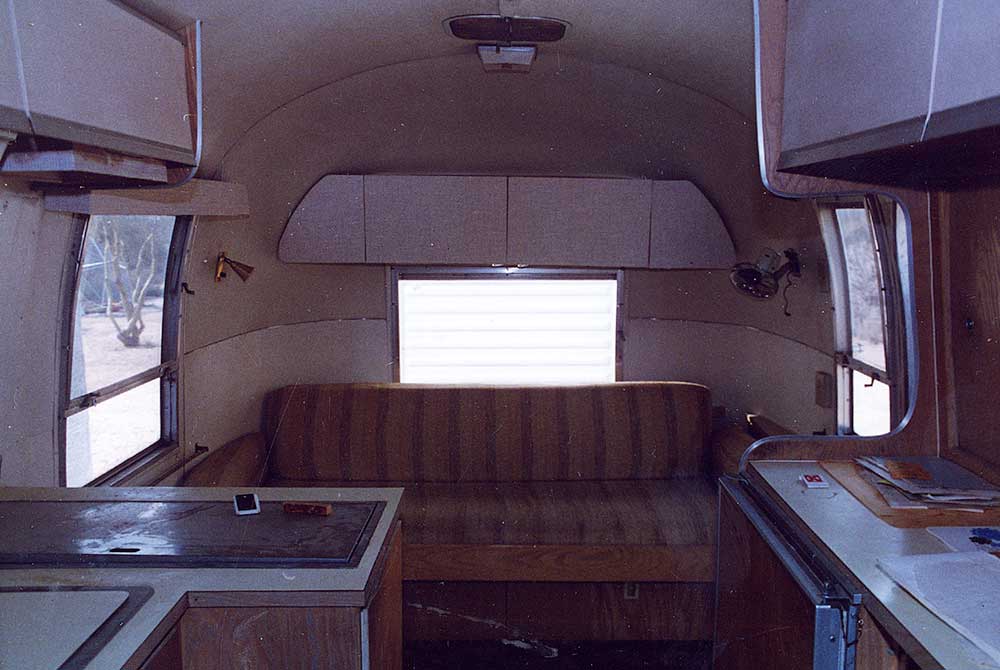
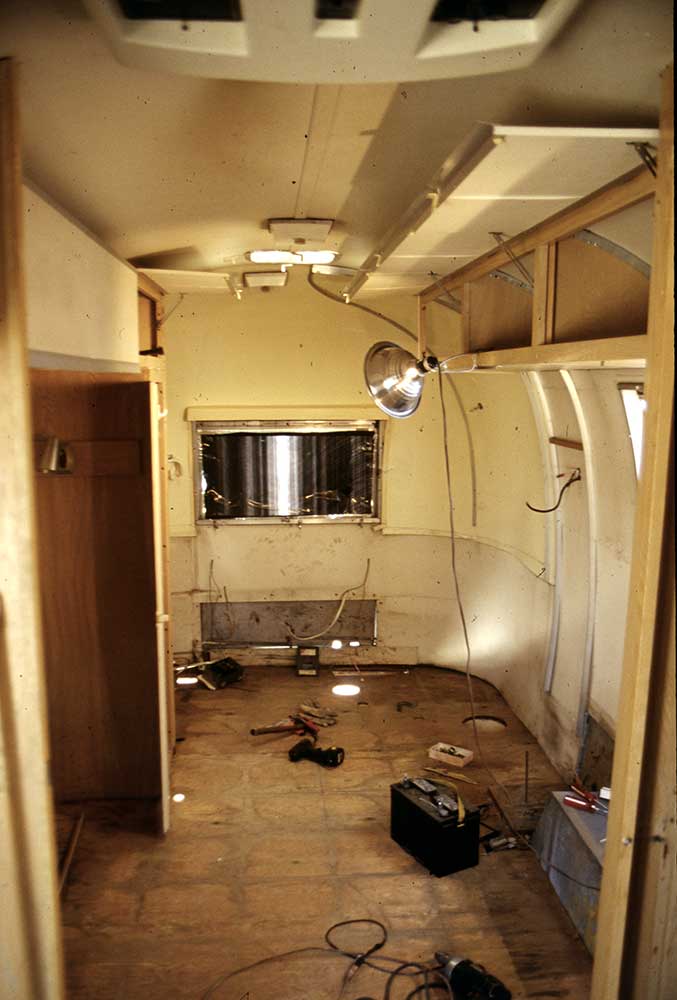
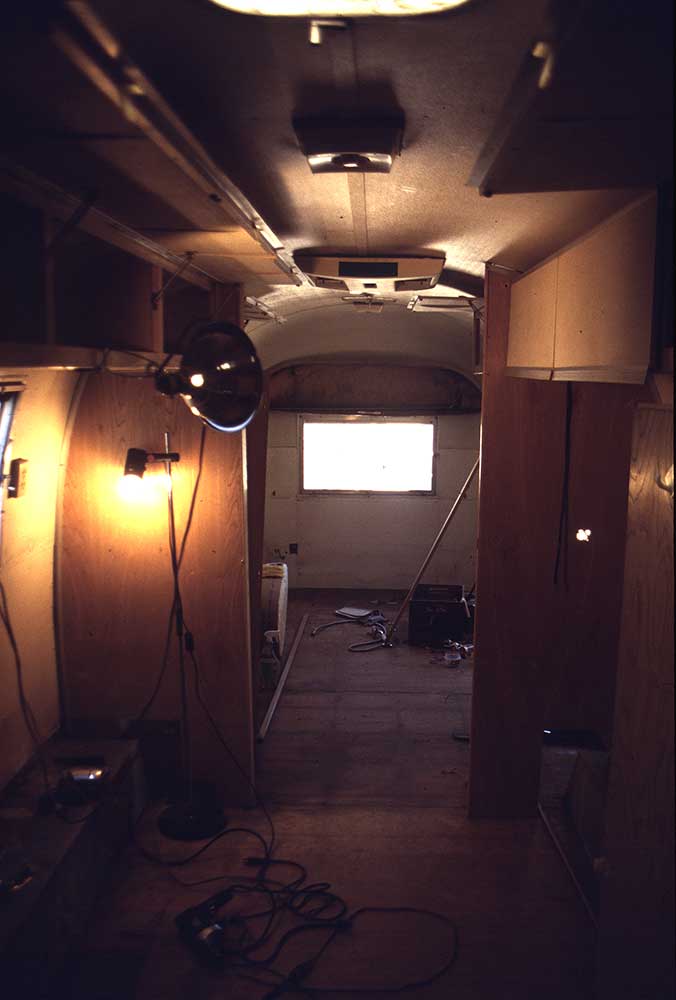
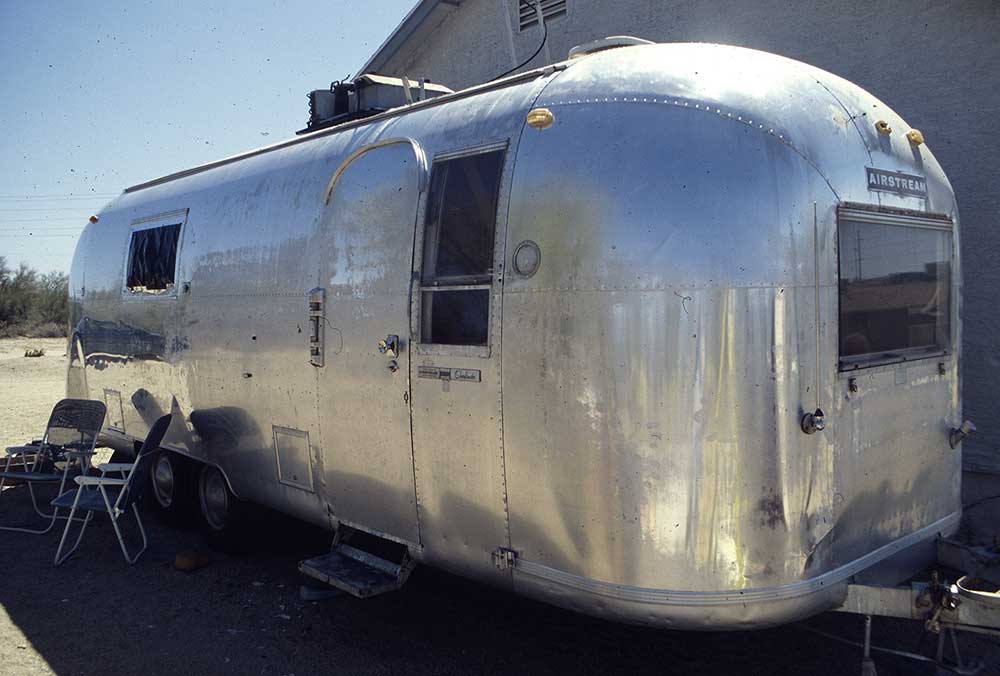
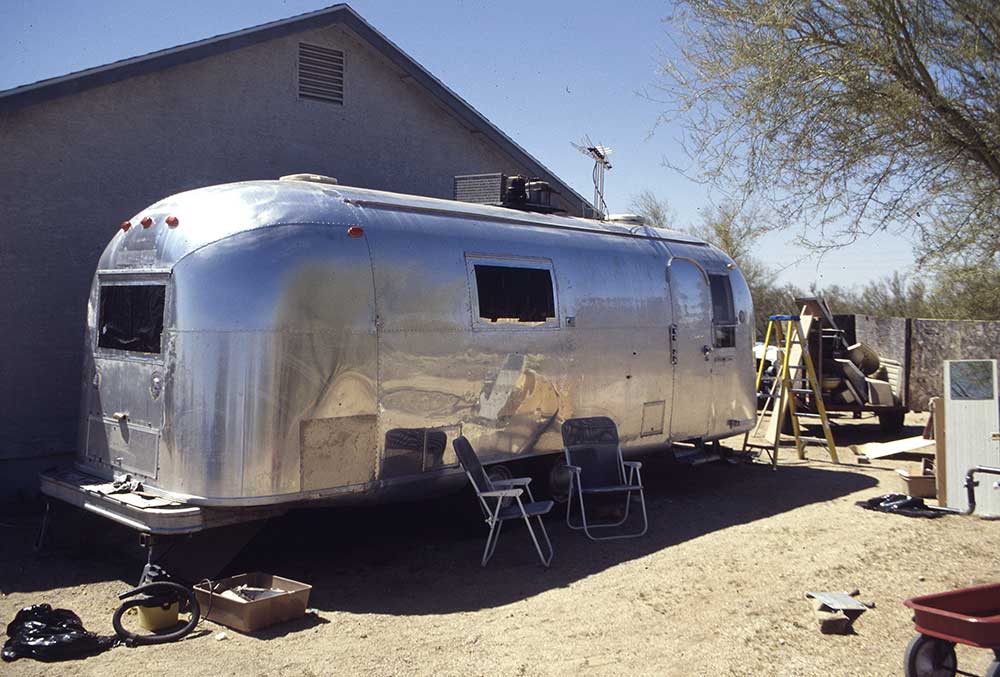
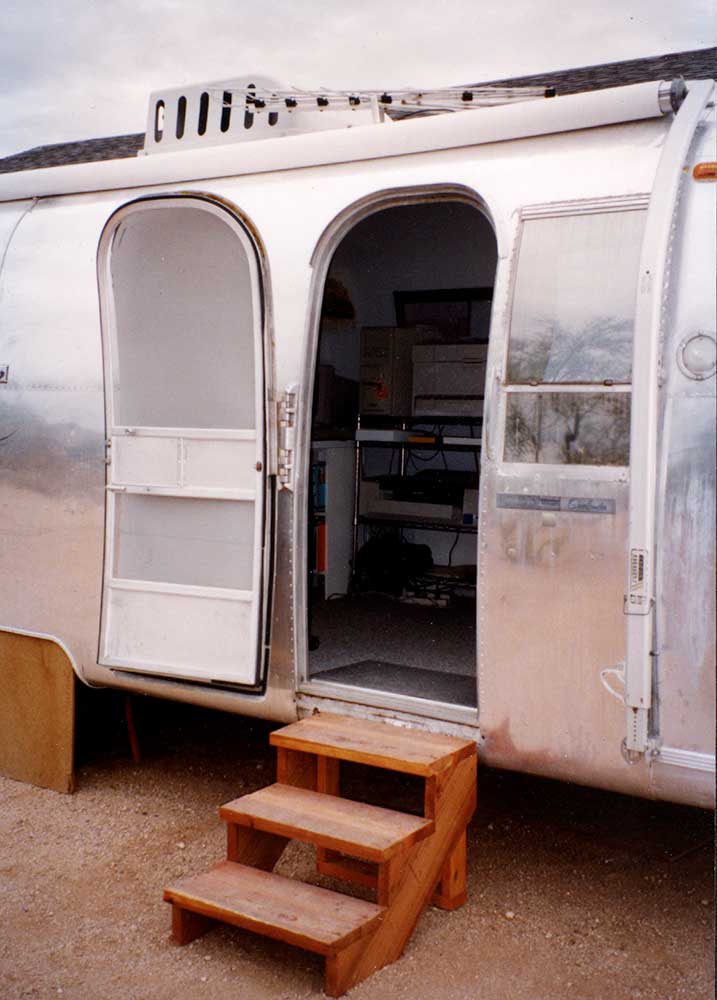
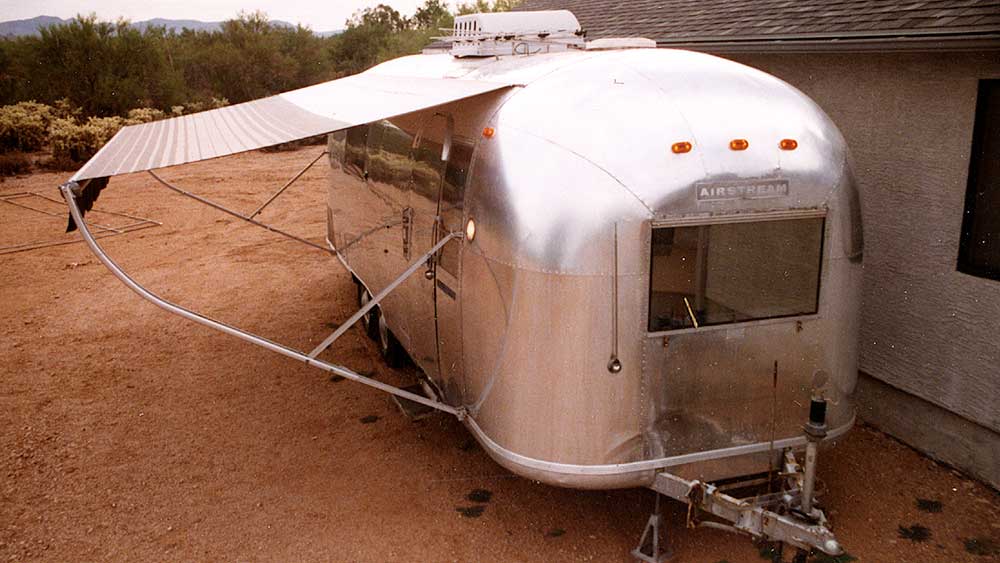
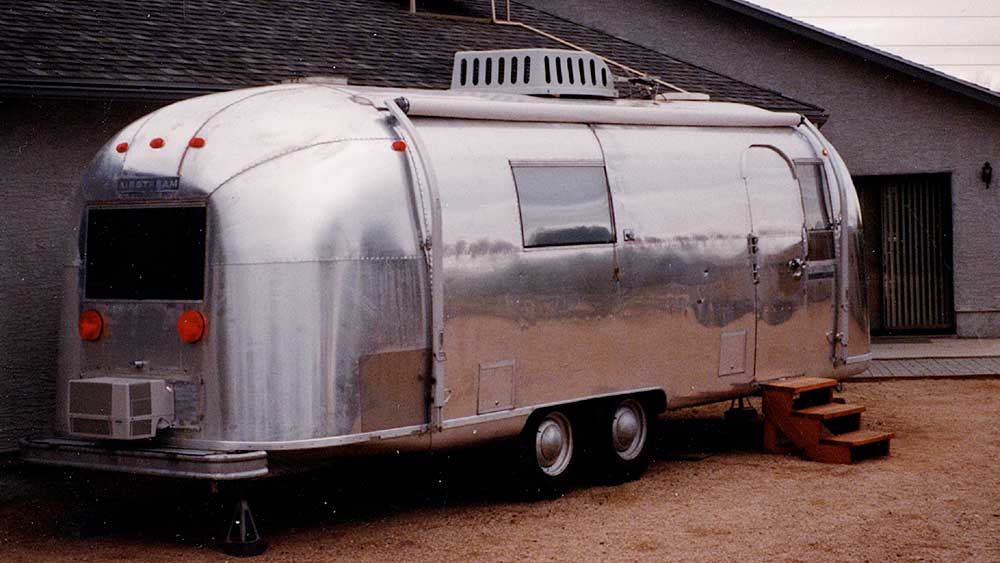
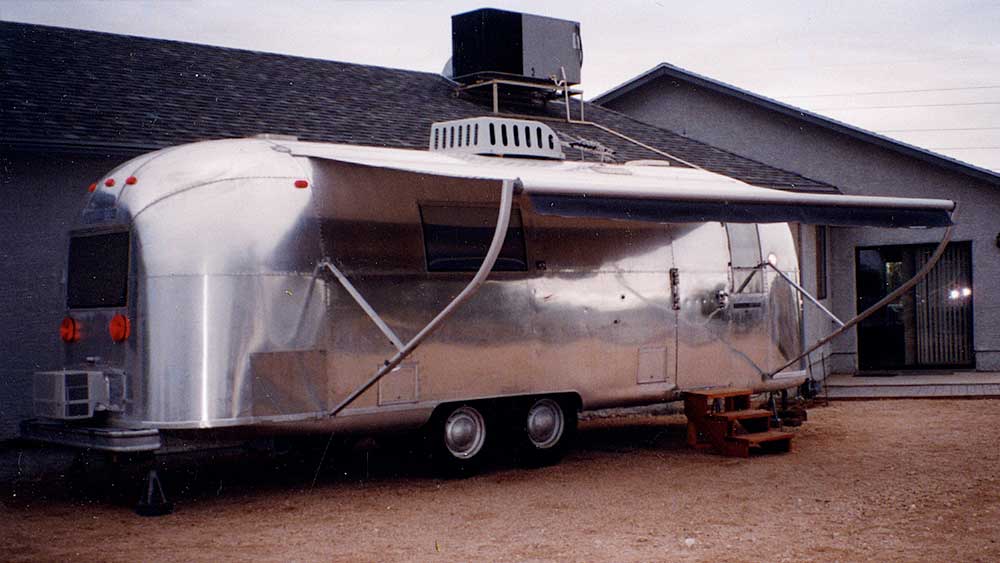
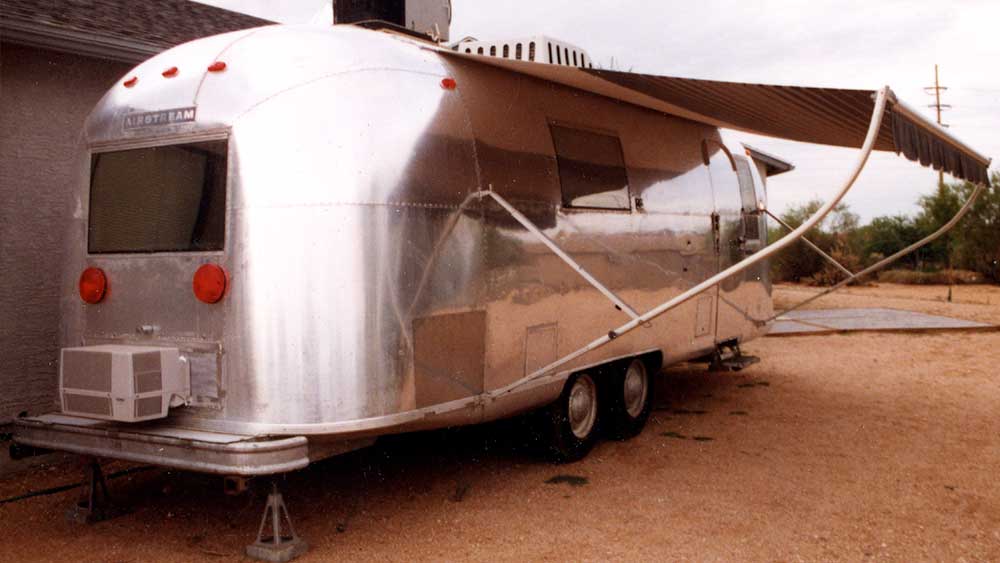
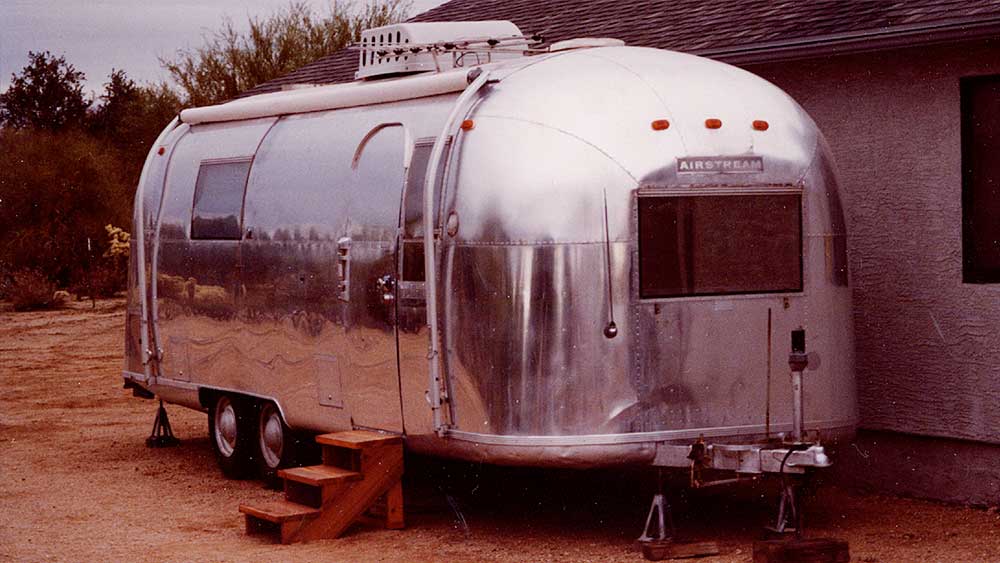
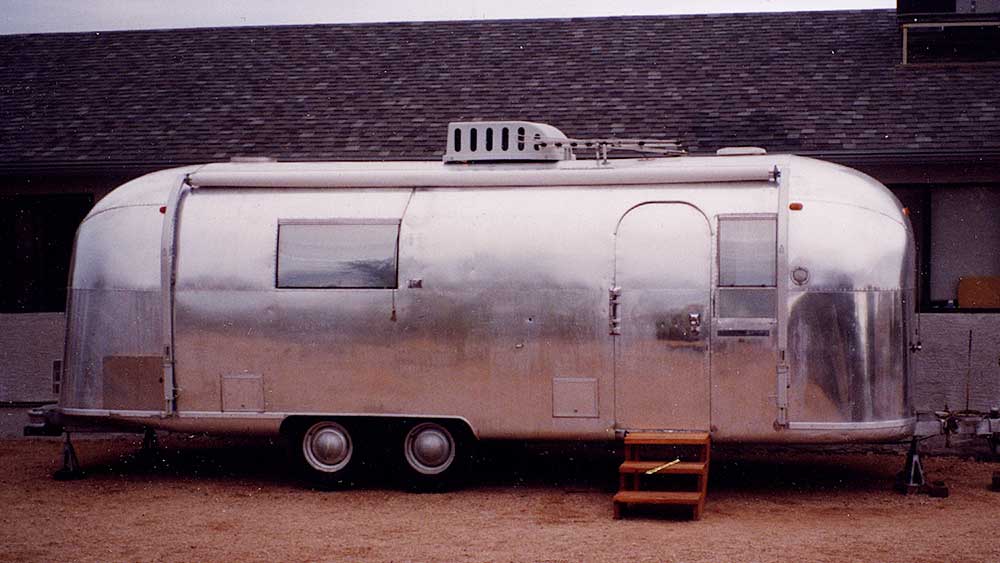
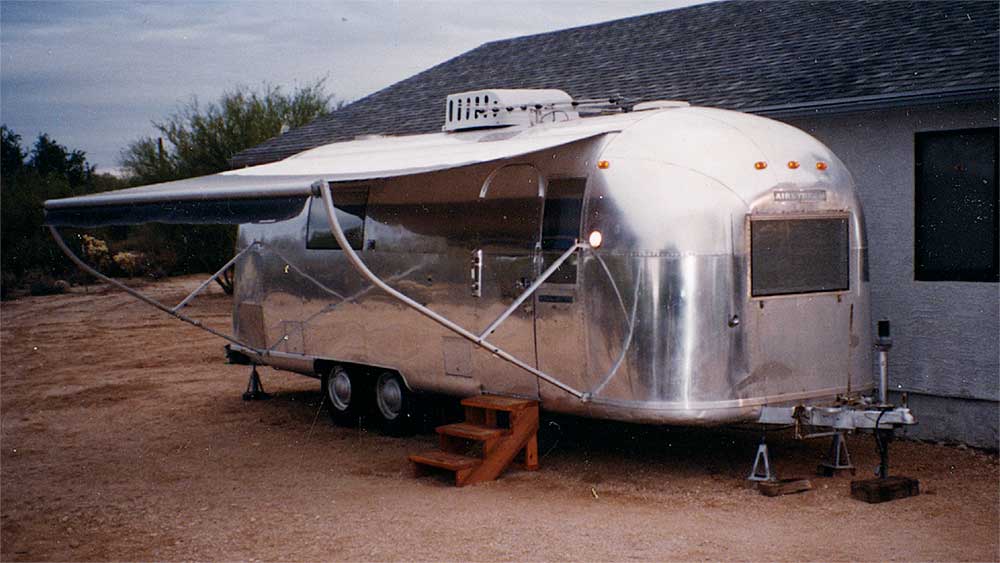
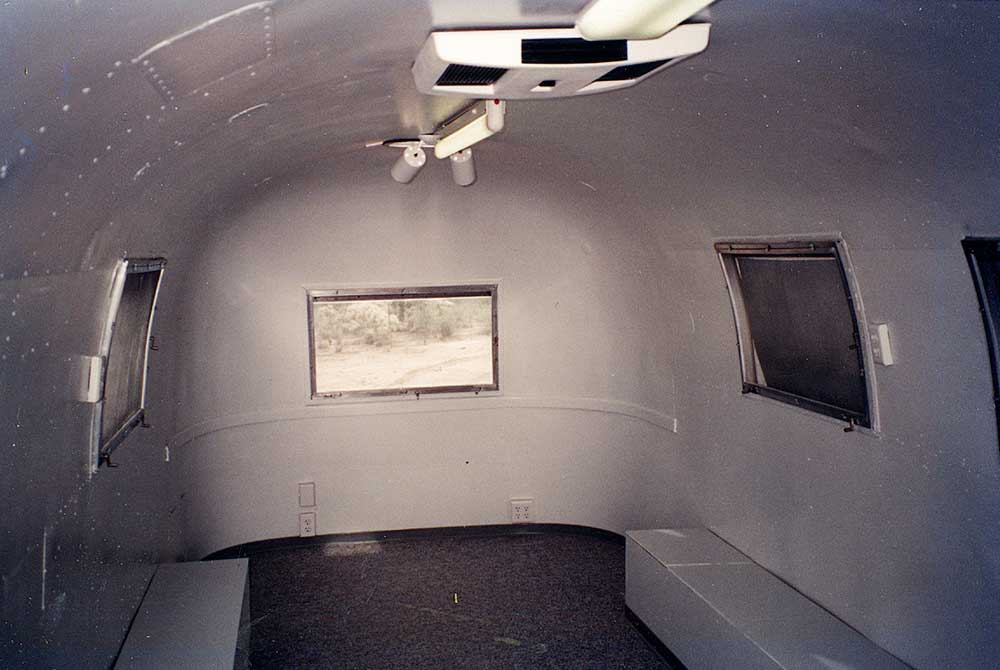
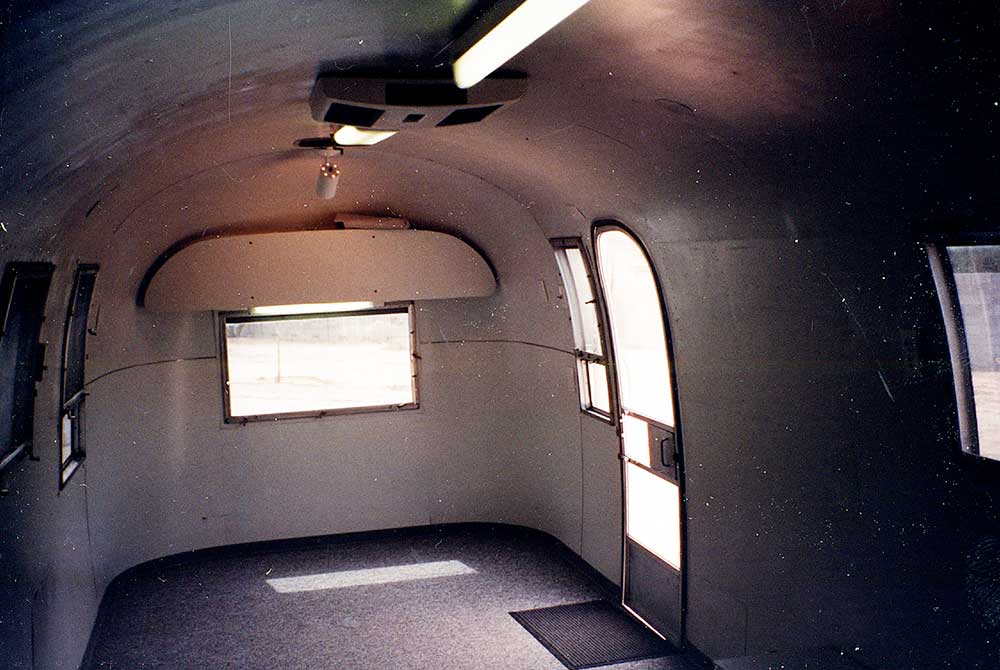
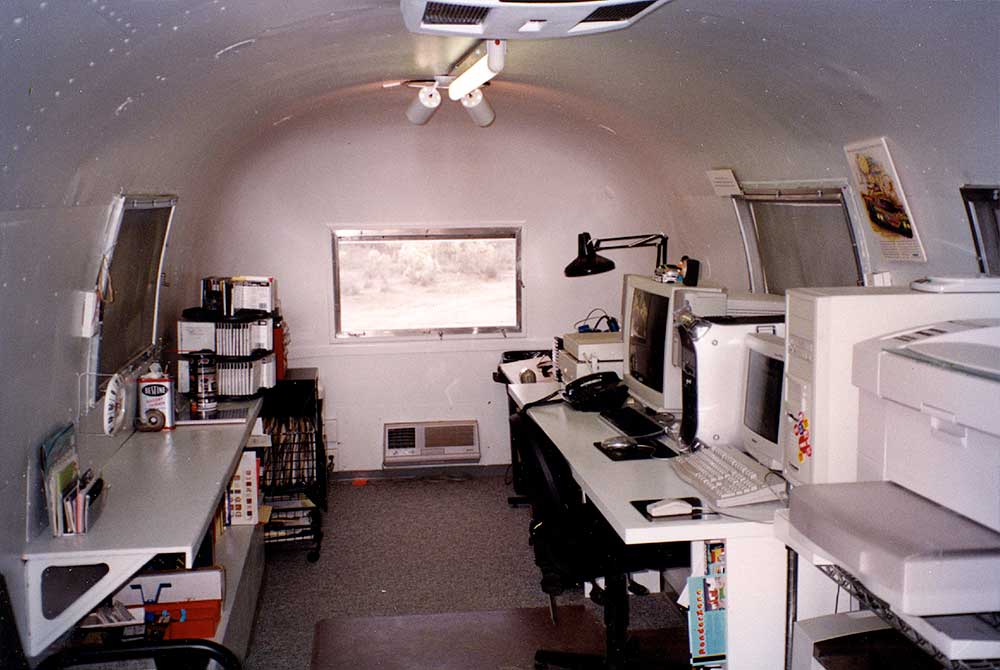
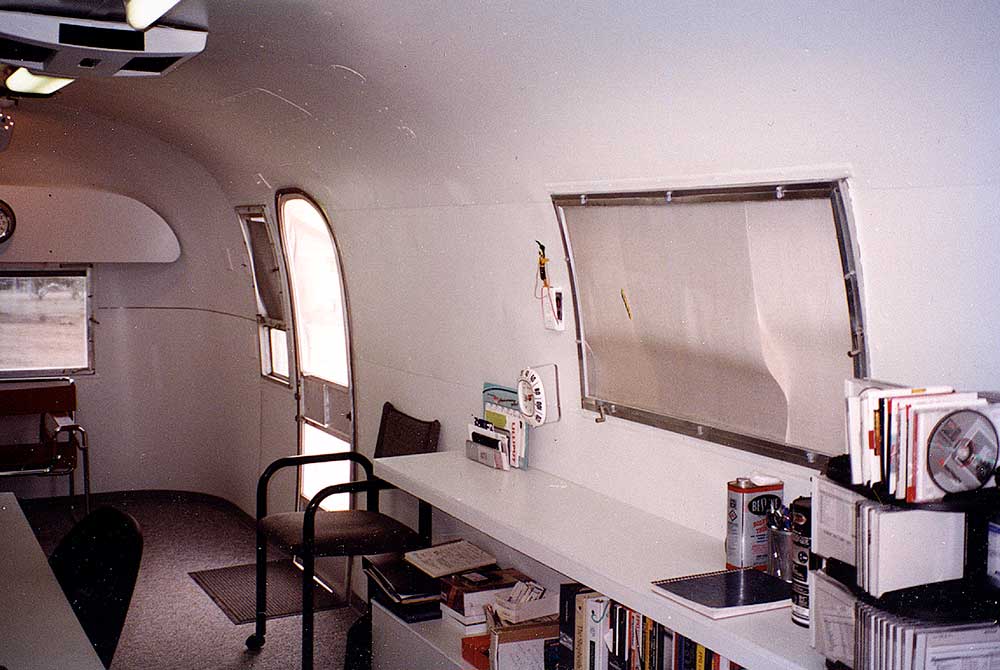
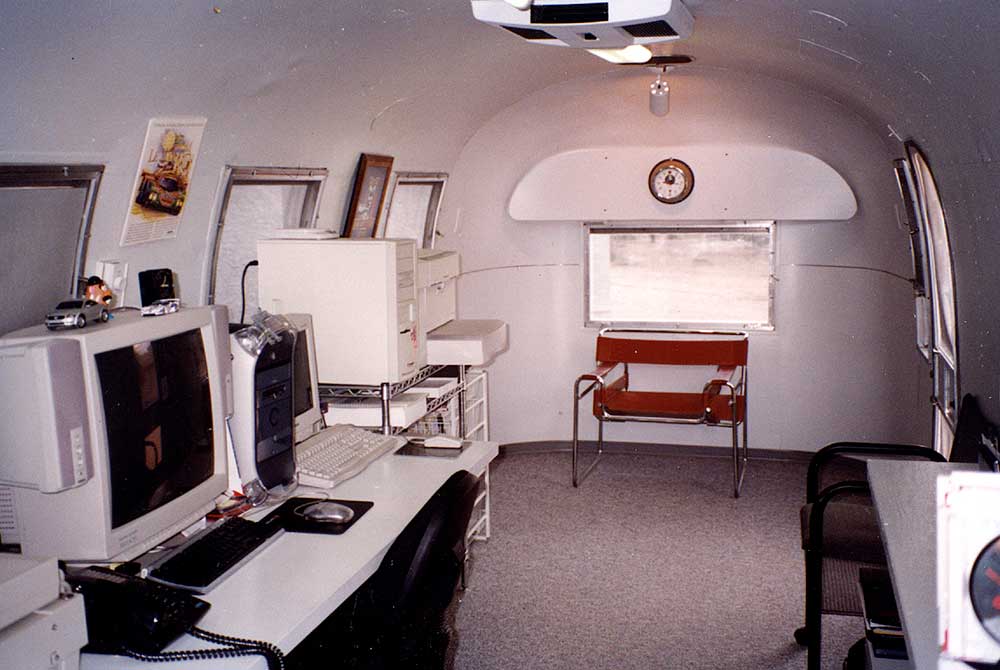
I’m saddened to hear that the Airstream Trailer didn’t work out for you as an office. I had considered doing this myself for a mancave/office, but living in the South, I know that even for mobile homes, you really need to have a garage canopy over the top of the trailer.
If I was going to build one, I’d definitely replace ALL of the fiberglass batting insulation with Spray-In Closed Cell Foam Insulation (which would require the forethought to rework all wiring, add Category 5 internet wiring, and rework the plumbing, so you could spray foam insulate the trailer). More costs
Funny story, Gary. Almost reminded me of my venture trying to convert a Swan 60 into my floating office in San Francisco bay. Will not go into details, but the bottom line was that I lost more than you trying to make it happen.
Roy
Gary, what a hilarious recounting of your adventure into rehabbing an Airstream! Love how you told about it, sorry it didn’t work out as planned. Sometimes the law of unintended consequences overwhelms good ideas.
Thanks for sharing this.
Phil Payne
I just cancelled that long-held idea. I have converted a recently evacuated off-spring bedroom into my new second-floor office with a grand view into our canyon. Whew! An inflatable guest sleeping apparatus will be neatly folded and stored in the garage until overnight guests are expected. I will gladly pay for the local hotel if necessary.
Looking for an Ariba Puck for camping.
I remember visiting one time and checking out your Airstream office, but it was after you had made all of the improvements. I never realized it was so much trouble, then. While I would’ve thought of the heat, I don’t think I’d have thought of the wind issues, especially with regards to the canopy. Good story!!
Gary,
Thanks for the enjoyable story. It was a nice change of pace.
Norm
Been there and done all that, but on 1950’s cars, just as difficult but more $$$$! although I at least get to drive them! CJ.
Fantastic! Thanks for your 200 hours, your $3500, and your narrative equanimity. The Airstream name is a magical conjuring and the Airstream image is a magical image. Your actual experienced reality is altogether valuable–thanks again…
As an anecdotal piece, your story was entertaining if somewhat misinformed, which I presume was for heightened humor value. Reading it, I couldn’t help but think why you chose an Airstream over some lesser trailer of more conventional design. It pained me to hear you recount the steps taken to convert such a wonderful, vintage unit mainly just for it’s exterior appearance as a backyard nostalgia piece.
You see, out of necessity and not whim, I lived in a 1972 Airstream in AZ and while I do agree there are some peculiarities in it’s solid design, I spent many occasions inside braving Phx dust storms and monsoons. Despite not being secured in any way, the thing was rock solid even during the worst conditions, an attribute anyone who’s ever towed one can attest to its aerodynamic stability.
As to the aluminum skin, my experience was that one could hold their hand on the surface longer than most any other sun-exposed surface and it was bearable. Not cool by any means but more bearable than say, a white painted car roof under same conditions.
Admittedly, the 30 year old rooftop AC had a tough time keeping its cool in the 112 -118 degree summers but on those days between the hours of 1 to 5 pm, I found the Mesa library as both a refreshing and intellectually stimulating retreat. I’d imagine putting it under a relatively inexpensive, free standing carport cover would do wonders at keeping the heat at bay.
I can’t imagine doing any wiring, however, as just the thought of dealing with the curved, riveted interior was overwhelming. And yes, the rear baths do provide a bit of challenge as the wooden floor underneath is often damaged and needs repair. But Airstreams are engineered to be built as close to sealed units as possible, which is why NASA used one as a quarantine unit for our returning astronauts. They were never meant to be taken apart and that has both good and bad points.
Other than that, I don’t know why anyone would want to remove the bathroom permanently. Airstreams are classics and to gut one for anything other than a complete restoration is almost sacrilegious, IMO. Had you at least kept the interior intact, unfitting as it may have been for your purposes, you likely would have gotten all your money back, plus.
But to each their own. Just know in your failed quest for nostalgic office space, one less American icon remains available for those of us who love and appreciate them. Sorry but I just don’t find that as entertaining a story as you thought it would be.
—My Airstream looked like it was in reasonable condition. As a designer, I respected and appreciated the design. But the reality was quite different from the fantasy. The Airstream had not been well maintained, had been stored outside for 32 years, and had dents in the shell.
Anything plastic that was exposed to the sun or heat was history, including several roof vents. In their deteriorated condition they exposed the interior to further water damage.
The door hinge was worn out. Its hinge mounts were buried under the riveted skin. Electrical, plumbing, floor damage, leaks, mouse droppings—it needed to be completely restored. The shell needed to be removed from the frame to properly replace the stinking floor. That constituted a frame off restoration.
What do you do with rotting wood under a fiberglass tub that was never intended to be removed, and too big to get out the door?
The air conditioner had been added at some point. Its plastic cover was history and the seals leaked. It cooled the trailer just fine. The problem was noise and vibration. I couldn’t work sitting right under all of that racket.
The Airstream, a brilliant design compared to travel trailers of the time, is just that, a travel trailer that was never intended to last indefinitely. The wood floor sandwiched between the shell and the frame sealed the temporary nature of the trailer. And as everyone knows or will discover, “RV” means ruined vacation.
The trailer was not worth restoring. Anyone would be far better off finding a trailer in excellent condition than spend the money restoring one that needed this much work. I actually ended up re-purposing the trailer instead of where it would have ended up sooner than later: scrapped.—Deans Garage
It is clear to see why thorough Airstream refurbishing or restoration is done “shell off”. Most of us driveway mechanics don’t have a practical way to do that.
I’m reminded of an old joke that ends with the dentist’s verdict: “Your teeth are fine but your gums have to come out.”
Hindsight is always 20-20, so you know now that a covered carport next to your garage would have solved your heat & rain issues. Checking Airstream forums may have also provided the useful advice for tackling the flooring & electrical issues. Still think it is a cool idea for an office. And, most importantly, you are a great Dad to give your sons their own space. Your article was very entertaining & provided a brief respite for me while caring for my 90 year old Mom on hospice.
Bravo Gary. That job is very similar to restoring any old car that is not a recognized valuable collectable. You can never get any meaningful ROI on these types of projects other than self satisfaction of job well done. Race cars fall into this category as well ….
BTW, I did notice the designer’s “calling card” can of Bestine !
Clark
Sorry Gary. Didn’t mean to come off sounding critical. Mine was almost as you described yours, except I didn’t have the floor rot issue. These older AS can and are refurbished and bring incredible sums of money. Of course, you either have to be familiar with the how-to of refurbishing one or invest tons of money having someone else do it for you. Either way is an undertaking, as you’ve discovered. So no offense meant and I hope none was taken. I did enjoy reading your article, even if it was just a little painful for me.
—There is an inverse relationship between rarity and practical restoration. There is no sense in restoring a rusted car if there are others available that aren’t rusted. If it’s the last one one the planet, that’s different. Same with this Airstream. The one I bought was not restoration worthy. If restoration was the goal, I would have searched for one in far better condition. Don’t be too heartbroken. Another few more years in the Arizona sun and it would have been so much aluminum scrap.—Deans Garage
@Clark Lincoln: Airstreams are, in fact, very collectible and valuable. There’s an avid, almost rabid, cult following. Refurbished ones easily bring five figures. New ones are already five figures strong. Custom ones are six figures.
As a sidenote, living in one made me understand and appreciate the quality of design and construction. I don’t think any travel trailer I may ever have will measure up to an Airstream.
I know it may sound crazy, but each one has a personality or vibe of its own. You get hooked.
Just like the 1961 Morris Minor panel wagon I owned. Hated it but would love to have another one!
I have to agree with Airstream Mike, but I won’t be as diplomatic as he was.
I consider this to have BEEN a very restorable Airstream, and Gary, you destroyed it.
Your Airstream was in far above average condition for a 1967. I do not see any issues about it that could not have been APPROPRIATELY and ECONOMICALLY addressed, and it could have become an exceptionally nice restoration in the hands of the right owner. This is a 49 year old trailer. Unlike most unrestored 49 year old cars that have survived this long intact, this Airstream (like most trailers) had most likely been stored outside all its life. From its appearance it looks like it spent most of its life in Arizona too, a big plus. You may have chosen to think of it as dented, but from you pictures it looks to me to be far nicer than most. Ditto regarding corrosion. Comparing it to other Airstreams of similar vintage, your Airstream had very nice skin. You complained that “The door hinges were worn out, its hinge mounts were buried underneath the skin”. Unless the hinge castings are cracked, these hinges can easily be reamed and rebushed, reassembled with a new pin, and will work as well as (and usually better than) when new. And if the hinge castings are cracked, used hinges are out there, and it is just a matter of drilling out rivets and realigning and reriveting as needed. The floor? Like all trailers, water gets into them, but it doesn’t get out. 99% of all vintage Airstreams need substantial or complete replacement of their original plywood floor. You didn’t do anything with the running gear or plumbing, but 99% of all vintage Airstreams with torsion axles need axle replacement, replacement of water and holding tanks, and very often structural repairs to the frame members as well. Vintage Airstream trailers are projects, no matter how original they may be, or how well they might have been protected from the elements.
I am pretty familiar with vintage Airstreams, having personally restored one that I still own and display with pride. I have also had a few other Airstreams pass through my hands, assisted fellow Airstream owners with their restorations, and performed pre-purchase inspections and offered advise to would-be Airstream owners. Airstreams are beautiful trailers, and Airstream’s marketing created a reputation of being absolutely the finest trailers made. Airstreams are indeed fine trailers compared to other brands, but they are far from perfect.
You had a very restorable Airstream. It was your choice not to see it as such.
—My Airstream was 32 years old at the time, not 49. My mistake was buying it in the first place. In any event, you’ll probably like the next post better than this one. It’ll be reviewing Airstream by Patrick R. Foster.—Dean’s Garage
OK Gary, I was a bit harsh in my comments. Thick as I am, I didn’t catch the meaning of your subtitle “Set the Wayback Machine to 1999”, and that your Airstream experience wasn’t a recent event. Airstream appreciation had not reached the stratospheric level back in 1999 that it has today. Your Airstream appears to be a 26′ Overlander, and the longer vintage models were not (and still are not) as highly valued as are the smaller models. With vintage Airstreams, the smaller they are, the greater their desirability, and thus their price. This is for a number of reasons: light enough to be towed with a vintage car, small to store, easy to tow, ability to fit in state park and similar small campsites, large enough for weekends trips, and attractive to display with your car at classic car rallies. I don’t view the gutting of a long 1967 Airstream in 1999 to be the same degree of loss as if it were being done today. In fact, it was fairly common to do so back then.
Gary,
Unlike some, I found this pretty funny, and sadly similar to some of my good idea adventures. Your gained understanding of something of which you had little knowledge at the point of origin smells more like victory than defeat to me. No one ever promises any of us our good ideas will be successful ventures; in fact, the challenge to succeed at a unlikely project is what motivates some of us. Good on you for chronicling the adventure, both for humor and information, I had little knowledge of the Airstream trailer either. Glad to know it went to a new enthusiast, and you survived to approach your next project!
agtxr7
I found the article quite funny as I believe it was intended to be… the follow up letters are probably more serious than the humor initially intended…. all together good fun AND informative!
What a great story!
It does unfortunately remind me of my years with my 31 ft express cruiser, navigating the adventures of Florida boating, I recently sold my lovely but insatiable watercraft after having spent ten years and a fortune keeping it running and of course looking good. Moving from Michigan boating to Florida boating, I was not totally familiar with the differences between these two great boating capitals. How different can it be?
Let me explain.
Of course I knew that I was running cooling salt water through two engines made largely of steel. But how bad could that be?
Well in my second year of boating I was faced with an overheated smoking engine. At least I was able to return to the marina with my other engine. But at the yard they explained that I really had to replace both engine manifolds that cost about eight grand and four weeks in the boat yard. I was also told that this would happen again to my engines in about 4–7 years. I could get a few more years out of them if I put in an expensive fresh water cooling system and dutifully flushed out both engines after each cruise. Of course that also resulted in a lot more hoses and tubing and connectors that could leak and need replacement periodically.
Then there is the fact that I now had two aluminum out-drives sitting in salt water all of the time resulting in another very expensive haul out each year and redoing the protective coatings and replacing the sacrificial aluminum anodes. They were installed so that the salt water would turn “them into swiss cheese” instead of your out-drives. The entire bottom of course had to be re coated every other year. All of this took about one to three weeks depending on how busy the boat yard was and more thousands $. Therefore the idea of leaving one’s boat in the water all year long in Florida was not exactly the reality.
Then there is the diver that had to “dive your boat” each month to clean the growth of slime and barnacles from your boat’s bottom. I tried having it done every “other” month once only to find out on the next “cruise” that the resulting drag on the hull prevented me from planing. For those not familiar with that condition let me describe it. Picture the bow of the boat aiming toward the sky. The scared passengers leaning way back against their seat backs, the engines sounding and feeling like they are going to over heat…blow up or both. Your top speed is about 10 miles per hour…leaving this embarrassed captain to idle all the way back to the marina and try to explain why the entire excursion is ruined. Fortunately I always kept lotsa beer in the boats frig.
Then there are the mussels that get into the sea water cooling intakes of the HVAC system, the cooling system of the gasoline generator and of course the flushing sea water toilet. They are supposed to be caught in the three separate filters in the bottom of the bilge (I slaved to keep my bilge a showcase of clean organization) which are to be removed and cleaned periodically. If that “periodically” is a little too long between cleanings it causes horrific clogging problems in the many feet of water lines associated with those systems deep in the bowels of the boat. I know.
Then there is the fact that the merciless Florida sun can turn that white beautiful, seemingly indestructible gleaming fiberglass into disgusting white chalk in about 6 months. The products that stave off this natural fact are costly in both in money and sweat. I used to enjoy it in my early 60s…now not so much.
At the marina I envied how the real yachts got pampered endlessly with crew after crew of matching logo shirted youngsters slaving away. No wonder the yachts looked so good! The owner was only seen on special occasions
Then there is the fact that boats are manufactured very much like your Airstream, Gary. I know because I worked in the cabinet shop one of the big manufactures down here for a month just for the experience. It was very cool…but.just for a month.
Finished floor and attached cabinets and appliances complete with wiring, plumbing and ducting are lowered by crane into the waiting lower hull with mating electrical, HVAC and plumbing -permanently attached together with little thought as to how to repair or replace. The upper deck is then permanently sealed to the lower hull with the expressed intent of never separating, short of a hurricane.
Years later there are available plans on where key items are located but there are dozens of mid year undocumented changes-often making the search for a component you are looking for a “treasure hunt”.
And then there are the tides to deal with. The intra-coastal waterway or ICW is a wonderful water highway running along our entire Eastern coast and around the Gulf. But it has it’s issues. Like sandbars that do not appear on the maps since they formed during the last storm. Tides that raise and lower the boat and it’s distance to the bottom by 5 and 6 ft at different times of the day. Tide charts are only accurate at the inlets to the ocean and the many miles of water between the inlets vary on the time of depth and current direction. Think of huge quantities of water rushing into and out of the ocean inlets. For those of you who saw how the freighters passing by on the Detroit River would strangely dry up the coastal beaches and then flood them again as they passed, know a little of this effect.
I can Identify with you Gary, even though we are at almost opposite ends of the country in desert vs ocean environments. Each with its joys and wonders and of course each sharing in the complete void of Michigan snow and sleet and misery.
I will probably get another boat again. I have always had a boat of one kind or another so I doubt I will go too long without one. Probably much smaller. But for now the rest is good. Thanks for sharing your adventure. I hope you enjoyed sharing mine.
Richard Ziemann, Clay Sculptor, Chief Sculptor, and Studio Manager, 1967-2002, GM Design Staff
—Thanks, Richard. Great story.—Dean’s Garage
Great story and illustration of the concept: “Scope creep.”
I can only add one of my favorite quotes, “Good judgment comes from experience and experience comes from bad judgment!”
—Or “Experience is the best teacher if you can afford the tuition.”—Dean’s Garage
Oh Gary, Gary, Gary….Why do we men torture ourselves with these giant projects that “looked” like small ones when we blindly buy a crumbling pile of rust, but in our eyes can only see ourselves driving the gleaming finished vehicle. After several successful restorations, my Waterloo was a very used 1966 Checker that my son bought and insisted was the “Icon of America”. I thought it would be a good father and son project. After pulling up the carpet and seeing mostly ground below, I knew we were in for a long haul, especially since we restored the car out of doors. But that’s another tortured tale that you really don’t want to hear. Thanks Gary for your wonderful tale of woe. There’s always a story behind every restoration, some bad and some worse.
—Good question. Poor genetic material? Brain damage?—Dean’s Garage
Gary, this is a great story well told. Back in the early Oughts, NDA decided to remodel the color studio, so we needed to move out to make way for the construction. Someone, I forget who, suggested we get some trailers to operate out of during the process, so with a connection to Airstream through Bryan Thompson, one of our designers, several folks went to Ohio to get three 22 ft trailers with bare interiors. Hauling them back to CA was a fun adventure, I’m told, although they nearly froze to death sleeping in them without furnaces.
The fun part was that we got to design the interiors and then had them made by our shop. No one put in shag carpet, but one had hex shaped ceramic tile, ours had bamboo and the third fake turf (so at least they didn’t have to wipe their feet on entry). Each unit was shared by two designers, except the one I was in. I was traveling much of the time, so we were three when I was around…needless to say, my mates were glad I was gone a lot.
The idea worked well for us, but after about two years, we were really happy to move back inside the studio at the conclusion of the renovation.
As a side note, my wife bought an Airstream back in ’09 after reading a book called “Sisters on the Fly.” (Seemed like a good idea at the time, like voting for Nixon, I suppose.) We used it a few times, but are now trying to sell.
—Thanks for the heads-up, but I moved back into my original home office when oldest son left home in 2001. Not interested. Maybe Airstream Mike or Joe Airstream would take it off your hands.—Dean’s Garage.
Gary: The only project with more turns is the 65 corvette. And that looks to be getting close to completion.
George
Alas, I have recommended to many would-be restorers that pushing their vehicle into the street and filing off the VIN is their best option. Nobody has ever taken my advice. But I once paid $3600 over the years to restore a $500 Chevy whose body had rotted off the frame, and another time I sunk $7000 into a car worth two grand, discovered the block was cracked, and finally just paid a guy to set it on fire and push it into a lake. It was the only way I could stop hemorrhaging money.
At least, with a motorized vehicle, I can recommend raising the radiator cap, rolling another, better vehicle underneath it, and lowering it back down to complete the ‘restoration’.
We have a saying: “This is my grandfather’s axe. My father replaced the head, and I replaced the handle.” But I’m going to hold on to that line about the gums to tell future clients.
As an owner of a ’49 Spartanette, I loved your story. They really were made as a sealed envelope. Once you break that seal, it just never goes back together again the same way. They’re like being inside a foil-wrapped baked potato in the sun- I lived in mine for 9 months, and we were out the door by sunrise every single day, not to return until dusk. People love ’em, though. Like all obsessions, if not for the passion, who would do such a thing?
—Indeed. Sealed envelope and baked potato. Perfect.—Dean’s Garage
Addendum: My wife has just pointed out that during the time we lived in the trailer, she would take a blanket and a headlamp into a nearby abandoned mine shaft and read books rather than be in the trailer in the afternoon.
—Nice! Dean’s Garage
Okay, as it turned out, we got the Bambi all fixed up, de-winterized, new batteries, new tires, exterior detailed, and now she doesn’t want to sell. In fact we just returned from a trip to Santa Fe to attend the Concorso, organized by Dennis and Beverly Little and had a great time. It was fun connecting with Dennis, Kip Wasenko and Allan Flowers, all from either GM Styling or Nissan Design days. The event was very well organized, too, with lots of truly interesting cars.
We also went up to Chama NM to ride the Cumbres & Toltec narrow gauge steam train, but we’re putting the trailer away for now and already thinking of another trip before winter.
Richard Ziemann’s story about adapting to the Florida salt climate reminds me of the lengths that Harley Earl went to preparing his final treat for himself after retirement. That was the F88 Mark 3 Olds. Before having it delivered to Florida, all electrical parts were dipped in liquid rubber. Everything that could be plated was triple chrome plated.
Turning the page to old Airstreams, I purchased a 1965 Airstream Sahara 22 footer in 1987. It was in the camping area at Waterford Hills Sportsman’s Club. It had never been out of use; never left in a field. It was all original, great shape. We towed it first with my ’73 Olds Cutlass Supreme Salon, then with my ’94 Caprice LT-1. When we upgraded to an Airstream motor home in ’97, a guy from Chicago answered my ad and bought the whole package.